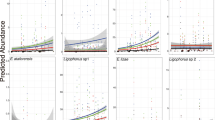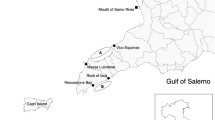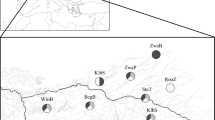Summary
An increased transmission of ectoparasites among individual animals is considered to be an inevitable cost of living in groups, since several kinds of ectoparasites require close proximity between large numbers of hosts for successful transmission. However, we do not know whether individuals belonging to group-living species incur a greater risk of ectoparasitism than individuals of solitary species. Here, using published data from 3 families (60 species) of Canadian freshwater fishes, I test the hypothesis that group-living species are host to more species of “contagious ectoparasites” (copepods and monogeneans) than solitary host species. As the different fish species have been studied with varying intensity, I used the mean number of parasite species recorded per study as a standard measure of parasite numbers. Multiple regression analyses were performed separately for each family to determine the effects of group-living and of 3 other variables (host size, age, and range) on the richness of the recorded parasite fauna. Once the effects of the other variables were removed, I found no significant effect of sociality on the richness of the parasite fauna per fish species, for contagious ectoparasites and other types of parasites. Neither of the other variables had any influence on the numbers of parasite species per fish species. These results suggest that a richer ectoparasite fauna is not a cost of group-living in fishes.
Similar content being viewed by others
References
Alexander RD (1974) The evolution of social behavior. Ann Rev Ecol Syst 5:325–383
Bertram BCR (1978) Living in groups: predators and prey. In: Krebs JR, Davies NB (eds) Behavioural Ecology: An Evolutionary Approach. Blackwell, Oxford, pp 64–96
Brown CR, Brown MB (1986) Ectoparasitism as a cost of coloniality in cliff swallows (Hirundo pyrrhonota). Ecology 67:1206–1218
Cheng TC (1986) General Parasitology (2nd edition). Academic Press, New York
Clutton-Brock TH, Harvey PH (1984) Comparative approaches to investigating adaptation. In: Krebs JR, Davies NB (eds) Behavioural Ecology: An Evolutionary Approach (2nd edition). Sinauer, Sunderland, MA, pp 7–29
Duncan P, Vigne N (1979) The effect of group size in horses on the rate of attacks by blood-sucking flies. Anim Behav 27:623–625
Freeland WJ (1977) Blood-sucking flies and primate polyspecific associations. Nature 269:801–802
Hoogland JL (1979) Aggression, ectoparasitism, and other possible costs of prairie dog (Sciuridae, Cynomis spp.) coloniality. Behaviour 69:1–35
Hoogland JL, Sherman PW (1976) Advantages and disadvantages of bank swallow (Riparia riparia) coloniality. Ecol Monogr 46:33–58
Kuris AM, Blaustein AR (1977) Ectoparasitic mites on rodents: application of the island biogeography theory? Science 195:596–598
Kuris AM, Blaustein AR, Alio JJ (1980) Hosts as islands. Am Nat 116:570–586
Margolis L, Arthur JR (1979) Synopsis of the parasites of fishes of Canada. Bull Fish Res Board Can 199
McPhail JD, Lindsay CC (1970) Freshwater fishes of northwestern Canada and Alaska. Bull Fish Res Board Can 173
Moore J, Simberloff D, Freehling M (1988) Relationships between bobwhite quail social-group size and intestinal helminth parasitism. Am Nat 131:22–32
Pagel MD, Harvey PH (1988) Recent developments in the analysis of comparative data. Quart Rev Biol 63:413–440
Pflieger WL (1975) The fishes of Missouri. The Missouri Department of Conservation, Missouri
Poulin R, FitzGerald GJ (1989) Shoaling as an anti-ectoparasite mechanism in juvenile sticklebacks (Gasterosteus spp.). Behav Ecol Sociobiol 24:251–255
Price PW, Clancy KM (1983) Patterns in number of helminth parasite species in freshwater fishes. J Parasitol 69:449–454
Pulliam HR, Caraco T (1984) Living in groups: is there an optimal group size? In: Krebs JR, Davies NB (eds) Behavioural Ecology: An Evolutionary Approach (2nd edition). Sinauer, Sunderland, MA, pp 122–147
Scott WB, Crossman EJ (1973) Freshwater fishes of Canada. Bull Fish Res Board Can 184
Slobodchikoff CN (1984) Resources and the evolution of social behaviour. In: Price PW, Slobodchikoff CN, Gaud WS (eds) A New Ecology. Wiley-Interscience, New York, pp 227–251
Smith PW (1979) The fishes of Illinois. University of Illinois Press, Chicago
Sokal RR, Rohlf FJ (1981) Biometry (2nd edition). W.H. Freeman, New York
Ward PI (1988) Sexual dichromatism and parasitism in British and Irish freshwater fish. Anim Behav 36:1210–1215
Author information
Authors and Affiliations
Rights and permissions
About this article
Cite this article
Poulin, R. Group-living and the richness of the parasite fauna in Canadian freshwater fishes. Oecologia 86, 390–394 (1991). https://doi.org/10.1007/BF00317606
Received:
Accepted:
Issue Date:
DOI: https://doi.org/10.1007/BF00317606




